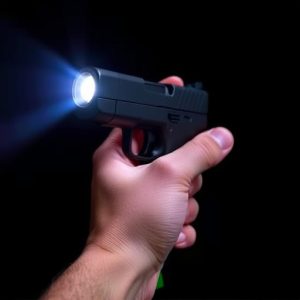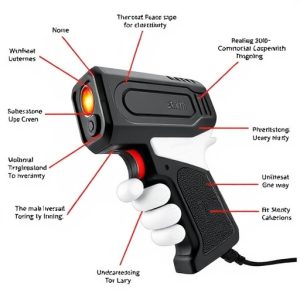Decoding Stun Gun Safety and Effectiveness: An Electrical Guide
Stun guns operate by delivering a high-voltage, low-ampere electric shock that temporarily disables…….
Stun guns operate by delivering a high-voltage, low-ampere electric shock that temporarily disables an attacker by disrupting neural signals and causing muscle contractions. Their effectiveness is determined by the design of the electrodes, circuitry, and the intensity of the pulse sequences, which must penetrate into the body's tissues to achieve their effect. The device's construction, including electrode placement and insulation properties, significantly influences how the electric charge is dispersed, affecting its reliability and effectiveness in self-defense scenarios. Stun guns are designed to deliver a shock that is strong enough to incapacitate but not so powerful as to cause significant injury. They function through battery-powered circuitry that charges capacitors, which then discharge an electrical current upon contact with an individual. The balance of high voltage and low amperage is critical for their safe and effective operation, and understanding how a stun gun works is essential for users to handle these devices responsibly, in compliance with legal regulations, and as part of a broader personal safety strategy that includes proper training and situational awareness.
When considering personal defense options, understanding how a stun gun functions is crucial. This article demystifies the mechanics of stun guns, exploring their electrical output and safety measures. We delve into the components that power a stun gun, including capacitors, current, and voltage, to clarify how does a stun gun work. Additionally, we address legal considerations and evaluate the effectiveness and limitations of stun gun shock in self-defense scenarios. Join us as we navigate the intricacies of stun gun technology for informed decision-making.
Understanding Stun Guns: The Mechanics Behind the Shock
Stun guns are self-defense devices that incapacitate an assailant through an electric shock, providing a non-lethal means of protection. To grasp how a stun gun functions, one must delve into its electrical output mechanism. At the core of a stun gun’s operation is its battery, which powers a high-voltage, low-ampere circuit. This circuitry generates an electric current that, upon contact with an individual, delivers a shock that disrupts muscle control and causes intense pain. The intensity of the shock is not solely dependent on voltage but also on the design of the electrodes and the capacity to deliver a rapid series of pulses rather than a single jolt.
The effectiveness of a stun gun hinges on its ability to produce an electric field that penetrates into the body’s tissues. The electrical output is specifically engineered to be highly disruptive to the neural signals that control muscle function, leading to involuntary muscle contractions and a loss of balance or consciousness. The device’s architecture, including the placement of the electrodes and the insulating properties of its casing, plays a critical role in how the electric charge is distributed. Understanding these aspects is crucial for anyone interested in the mechanics behind stun guns, as it directly influences their reliability and efficacy in self-defense situations.
Electrical Components of a Stun Gun: Capacitors, Current, and Voltage
Stun guns are non-lethal self-defense tools that incapacitate an attacker by delivering a high-voltage, low-current electrical shock. The effectiveness of a stun gun is primarily due to its electrical output, which can be understood by examining the role of capacitors, current, and voltage within its design.
At the heart of a stun gun’s electrical system are the capacitors, which store electrical energy. These capacitors are charged during the preparation phase of using the device. When activated, the capacitors release their stored energy, creating an electric current that flows through the stun gun’s probes. The voltage produced by these capacitors is a key factor in the operation of the stun gun; it determines the intensity of the shock delivered. A stun gun typically operates at voltages ranging from 50,000 to 1,000,000 volts, which is sufficient to cause neuromuscular incapacitation without causing significant injury.
The current, on the other hand, is the flow of electrical charge that reaches the attacker. A stun gun delivers a high-voltage, low-amperage electric current. The amount of current is generally kept low because a higher amperage could lead to muscle damage or even cardiac arrhythmia, which could be dangerous. This balance between voltage and current ensures that the stun gun delivers an incapacitating shock that can effectively deter an attacker without causing permanent harm. Understanding how these electrical components interact is crucial for grasping how a stun gun works and for ensuring its safe and effective use in self-defense situations.
Safety and Legal Considerations When Handling Stun Guns
Stun guns are self-defense devices that deliver a high-voltage, low-ampere electrical charge to incapacitate an attacker. Understanding how a stun gun works is fundamental to its safe and legal handling. The device typically utilizes electrodes to deliver the charge, which causes muscle contractions and disorientation in the target individual. When considering safety and legality, it’s crucial to be aware of the local laws governing stun gun possession and use, as these can vary significantly by jurisdiction. In some regions, there may be restrictions on who can own a stun gun, where they can be carried, and under what circumstances they can be used for self-defense. Proper training is also essential to ensure the device is used safely and effectively, minimizing the risk of accidental injury or misuse. Users must familiarize themselves with the stun gun’s mechanisms, including how to hold it correctly, aim effectively, and understand the potential effects on both the attacker and themselves, particularly in cases where the individual may be sensitive to electrical stimulation due to medical conditions. Safety protocols should always be followed to avoid any unintended consequences, ensuring that the stun gun is a reliable tool for personal protection within the confines of the law.
Effectiveness and Limitations: Assessing the Impact of Stun Gun Output in Self-Defense Situations
Stun guns are non-lethal self-defense tools that incapacitate an assailant by delivering a high-voltage, low-ampere electrical shock, effectively disrupting the muscle function of the target. The effectiveness of a stun gun is primarily determined by its electrical output, which dictates how well it can interrupt an attacker’s motor skills and cause intense pain. A stun gun operates by emitting an electric current that rapidly depolarizes the membrane of muscles and nerves, leading to involuntary muscle contractions and a disorienting sensation. The electrical output, measured in milliamperes (mA) and volts (V), is a critical factor in determining the intensity of the shock and, consequently, the effectiveness of the stun gun.
However, the effectiveness of stun guns in self-defense situations is not without limitations. The output must be sufficient to overcome the natural pain threshold of an attacker, which can vary significantly from person to person. Additionally, environmental factors such as weather conditions and proximity to the target can affect the stun gun’s performance. For instance, humidity can reduce the effectiveness of the electrical charge. Moreover, a stun gun is typically less effective on individuals under the influence of drugs or alcohol, or those who are particularly large or muscular, as they may have a higher pain threshold and their muscle mass could absorb more of the charge. Understanding how does a stun gun work is essential for users to operate these devices safely and effectively in self-defense scenarios. Users must be aware that while stun guns can be powerful tools for self-protection, they are not foolproof and should be used within the context of personal defense strategies that include situational awareness and escape tactics.


